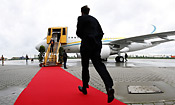India Awakens

Even if you have never gone to India--never wrapped your food in a piping-hot naan or had your eyeballs singed by a Bollywood spectacular--there is a good chance you encounter some piece of it every day of your life. It might be the place you call (although you don't know it) if your luggage is lost on a connecting flight, or the guys to whom your company has outsourced its data processing. Every night, young radiologists in Bangalore read CT scans e-mailed to them by emergency-room doctors in the U.S. Few modern Americans are surprised to find that their dentist or lawyer is of Indian origin, or are shocked to hear how vital Indians have been to California's high-tech industry. In ways big and small, Indians are changing the world.
Related
Bombay's Boom
Brash, messy and sexy, India's biggest city embodies the nation's ambition. How Bombay is shaping India's future--and our own
Hooray for Bollywood
With Americans embracing our culture, can Indians like me keep it real?
My Lost World
On a return to his provincial hometown, Aravind Adiga discovers how wealth is uprooting tradition and transforming India's way of life
How to Ride the Elephant
Indian stocks have taken a tumble. But here's why the country's long-term prospects remain bright--for Indians and investors
|
Multimedia
|
 |
That's possible because India--the second most populous nation in the world, and projected to be by 2015 the most populous--is itself being transformed. Writers like to attach catchy tags to nations, which is why you have read plenty about the rise of Asian tigers and the Chinese dragon. Now here comes the elephant. India's economy is growing more than 8% a year, and the country is modernizing so fast that old friends are bewildered by the changes that occurred between visits. The economic boom is taking place at a time when the U.S. and India are forging new ties. During the cold war, relations between New Delhi and Washington were frosty at best, as India cozied up to the Soviet Union and successive U.S. Administrations armed and supported India's regional rival, Pakistan. But in a breathtaking shift, the Bush Administration in 2004 declared India a strategic partner and proposed a bilateral deal (presently stalled in Congress) to share nuclear know-how. After decades when it hardly registered in the political or public consciousness, India is on the U.S. mental map.
Among policymakers in Washington, the new approach can be explained simply: India is the un-China. One Asian giant is run by a Communist Party that increasingly appeals to nationalism as a way of legitimating its power. The other is the largest democracy the world has ever seen. The U.S. will always have to deal with China, but it has learned that doing so is never easy: China bristles too much with old resentments at the hands of the West. India is no pushover either (try suggesting in New Delhi that outsiders might usefully broker a deal with Pakistan about Kashmir, the disputed territory over which the two countries have fought three wars), but democrats are easier to talk to than communist apparatchiks. Making friends with India is a good way for the U.S. to hedge its Asia bet.


 Waldheim's Skeletons
Waldheim's Skeletons Bloomberg and Schwarzenegger: The New Action Heroes
Bloomberg and Schwarzenegger: The New Action Heroes Is the Space Station a Money Pit?
Is the Space Station a Money Pit? Top Shots From Google's Candid Camera
Top Shots From Google's Candid Camera A Dogfight Over Private Jets
A Dogfight Over Private Jets